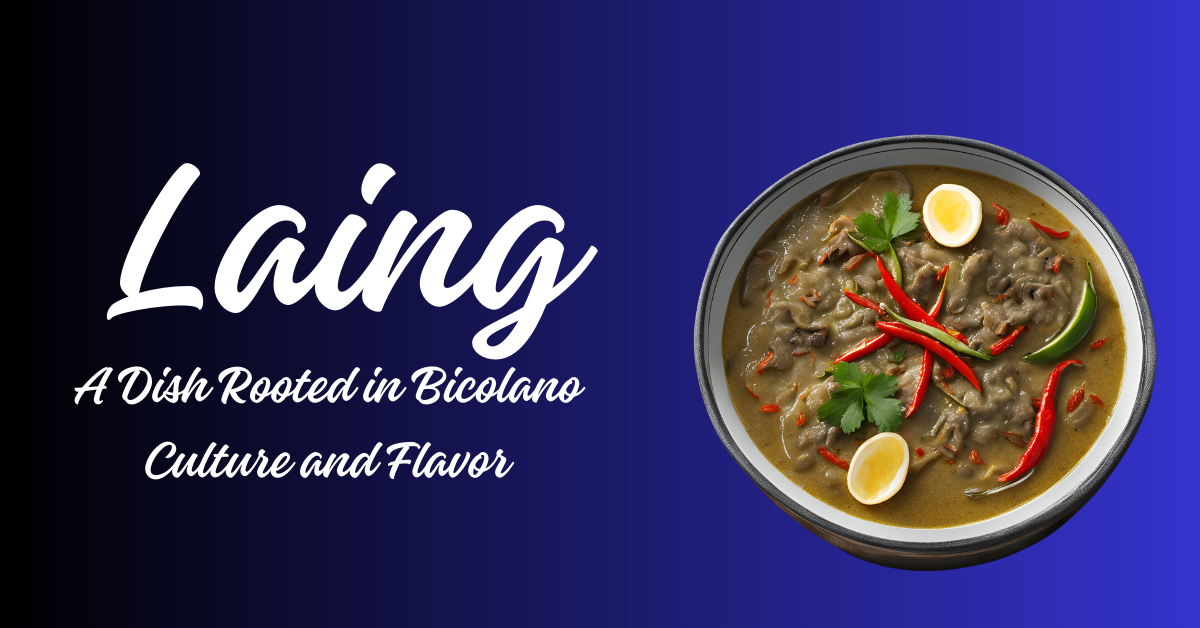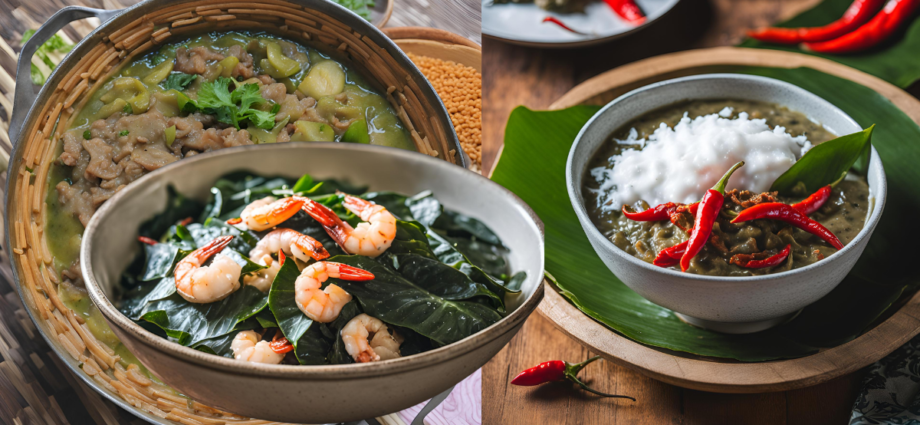Laing, one of the most beloved dishes from the Bicol region of the Philippines, is a flavorful representation of the area’s agricultural richness and deep connection to coconut-based dishes. Bicol, located in the southern part of Luzon, is known for its fertile land that yields coconuts and an abundance of root crops like taro (gabi). The region’s cuisine reflects this bounty, blending coconut milk and chili into dishes that have become synonymous with Bicolano culture.
Laing specifically showcases this combination: dried taro leaves cooked in rich coconut milk (gata) and flavored with shrimp paste or dried shrimp, chili peppers, garlic, and ginger. Traditionally, Bicolano households would use fresh ingredients from their backyards—taro leaves from the garden and coconuts harvested for fresh milk. Over the years, laing has become a staple dish not just in Bicol but across the Philippines, often appearing at festive gatherings and Sunday family meals.

History and Geographic Origins
The origins of laing are closely tied to the Bicolano people’s agricultural traditions. Known for their love of spicy and creamy dishes, Bicolanos have mastered the use of gata (coconut milk) in many recipes, with laing standing out as one of the most iconic. The abundance of taro (gabi) in Bicol made it a primary ingredient, and the leaves, stems, and roots were used in various dishes. The method of slow cooking taro leaves in coconut milk, paired with chili for heat, likely evolved as a way to create a hearty, satisfying meal using readily available resources.
The dish’s flavor profile—creamy, spicy, and savory—speaks to the influences of Malay and Spanish cooking, which left their marks on Filipino cuisine during the country’s colonial history. However, Bicolano dishes like laing have retained their unique regional identity through the use of local ingredients and distinct preparation techniques. Today, laing continues to be celebrated as a symbol of Bicol’s culinary heritage, often prepared during special occasions or as a comforting everyday meal.
You Might Also Be Interested: Savory Delight: Journey into Filipino Cuisine with Balbacua
Classic Laing Recipe: A Comprehensive Guide
Ingredients:
• 250g dried taro leaves (ensure the leaves are fully dried to avoid itchiness)
• 400ml coconut milk (preferably fresh, but canned works too)
• 200ml coconut cream (kakang gata) for added richness
• 250g pork belly or dried fish (optional for added flavor)
• 2-3 tablespoons shrimp paste (bagoong alamang) or dried shrimp for a rich umami taste
• 4-5 red or green chili peppers (adjust to your heat preference)
• 1 onion, finely chopped
• 4 cloves garlic, minced
• Thumb-sized piece of ginger, peeled and sliced thinly
• Salt and pepper to taste
Preparation Instructions:
1. Prepare the Ingredients:
• Ensure the taro leaves are fully dried; fresh leaves can cause itchiness when cooked. Rinse gently if needed, and set aside.
• If using pork belly, cut it into bite-sized pieces. For a more traditional take, dried fish like daing or tinapa can be substituted.
2. Sauté Aromatics:
• In a large pan or pot, heat some oil and sauté the onion, garlic, and ginger until fragrant.
• Add the shrimp paste or dried shrimp, and continue cooking until it’s well incorporated into the aromatics.
3. Add the Coconut Milk:
• Pour in the coconut milk, bringing it to a gentle simmer. Stir occasionally to avoid curdling.
• Add the pork or dried fish, if using, and simmer for 10-15 minutes until the meat is tender and fully cooked.
4. Cook the Taro Leaves:
• Gradually add the dried taro leaves to the simmering coconut milk mixture. Do not stir immediately; allow the leaves to absorb the liquid and soften naturally.
• Once the leaves have absorbed the coconut milk and settled, gently stir to ensure they’re evenly coated. Simmer the mixture on low heat for about 30-40 minutes, allowing the flavors to meld together. Stir occasionally, but be careful not to break the leaves.
5. Finish with Coconut Cream and Chili:
• Add the coconut cream to enrich the sauce, making it thicker and creamier.
• Toss in the chili peppers—you can leave them whole for a milder flavor or slice them open for more heat.
• Simmer for another 10-15 minutes, letting the sauce thicken and the oil rise to the top, which is a sign that the laing is ready.
6. Season and Serve:
• Taste the dish and adjust seasoning with salt and pepper.
• Serve your laing with steamed rice and enjoy it as a main dish or side.
Cooking Tips:
• Use dried taro leaves: Fresh taro leaves contain calcium oxalate, which can cause itching or irritation. Using dried leaves eliminates this issue.
• Simmer slowly: Laing is a dish that benefits from slow cooking, allowing the taro leaves to fully absorb the flavors of the coconut milk and spices.
• Balance the heat: If you’re not accustomed to spicy food, reduce the number of chili peppers. You can also add more coconut cream to mellow out the spice.
Conclusion
Laing’s journey from the Bicol region to dining tables across the Philippines and beyond highlights the enduring appeal of this simple yet flavorful dish. Its rich history, rooted in Bicolano agricultural practices and local ingredients, speaks to the resilience and creativity of Filipino cuisine. Whether you’re a fan of spicy food or just looking to explore more traditional Filipino dishes, laing is a perfect gateway into the flavors of Bicol. Pair it with steamed rice and other classic Bicolano dishes like Bicol Express for an authentic culinary experience.
With its creamy texture, vibrant flavors, and cultural significance, laing remains a beloved dish that continues to captivate both locals and visitors alike.
You Might Also Like:
Nasi Goreng with Egg: Unraveling the Indonesian Culinary Gem
The Journey of Pad Thai: From Streets of Thailand to Your Plate
Crispy Fried Chicken Delight: A Filipino Favorite
Exploring the Flavorful Chicken Adobo: A Filipino Classic
7 Must-Try Bites for Your Singaporean Food Adventure
Paksiw na Bangus: A Flavorful Filipino Classic
- Top Digital Nomad Cities in Latin America (2026 Edition) - 15 December 2025
- Top Digital Nomad Cities in Europe (2026 Edition) - 14 December 2025
- Top Digital Nomad Cities in Asia (2026 Edition) - 14 December 2025











